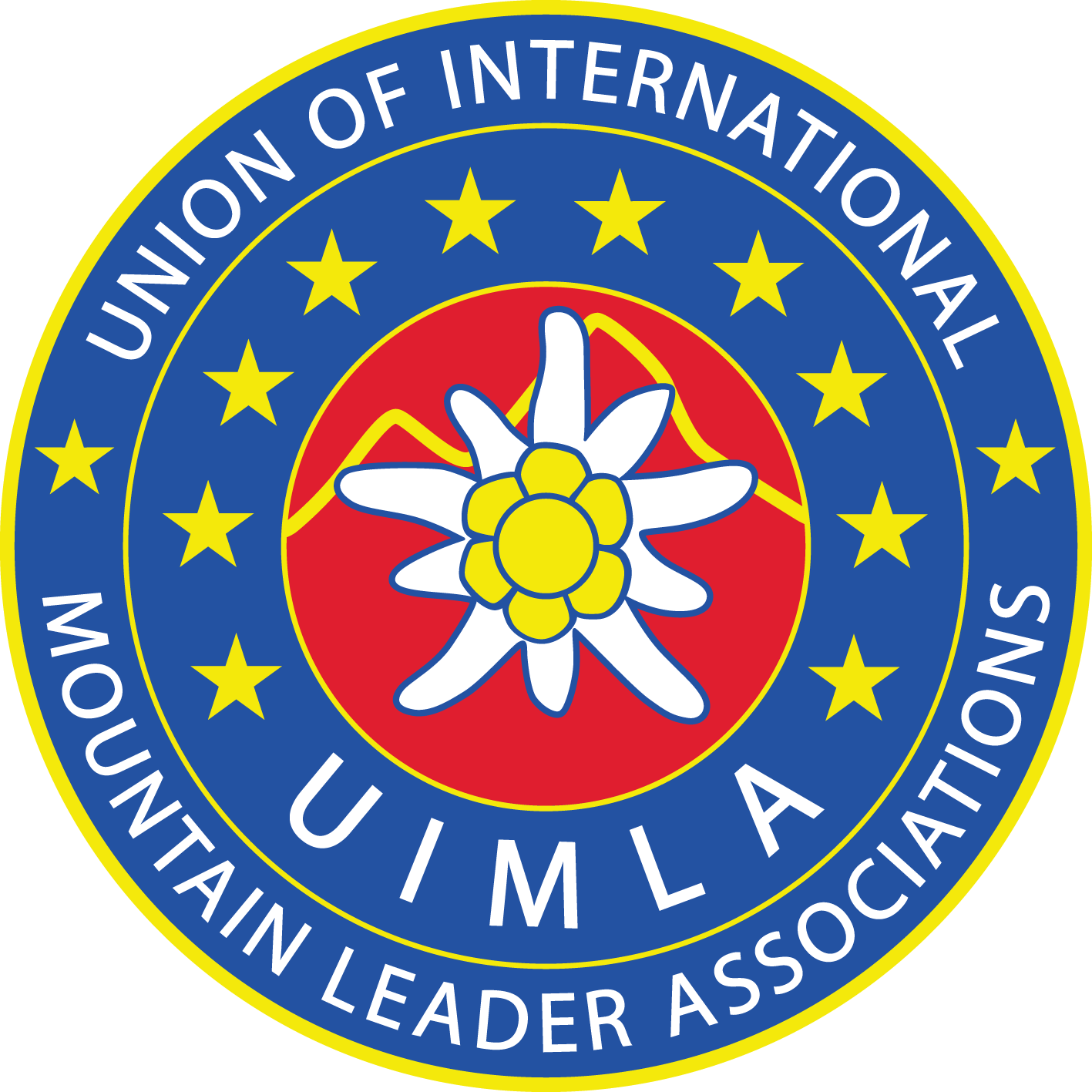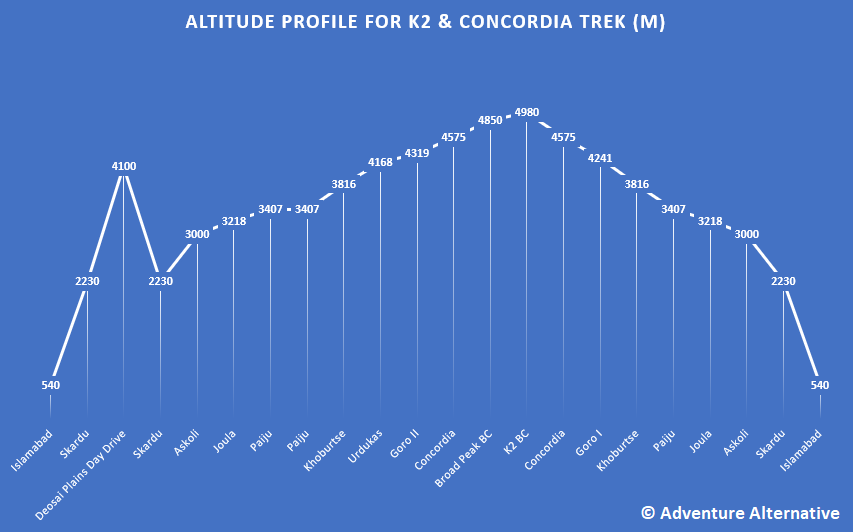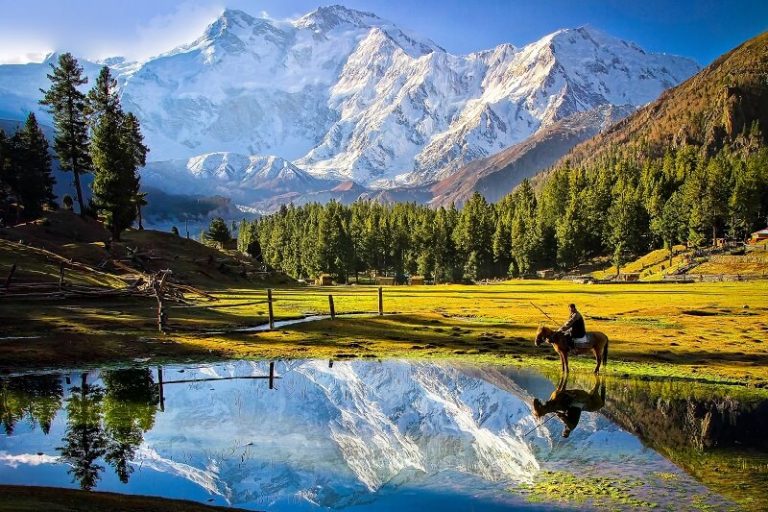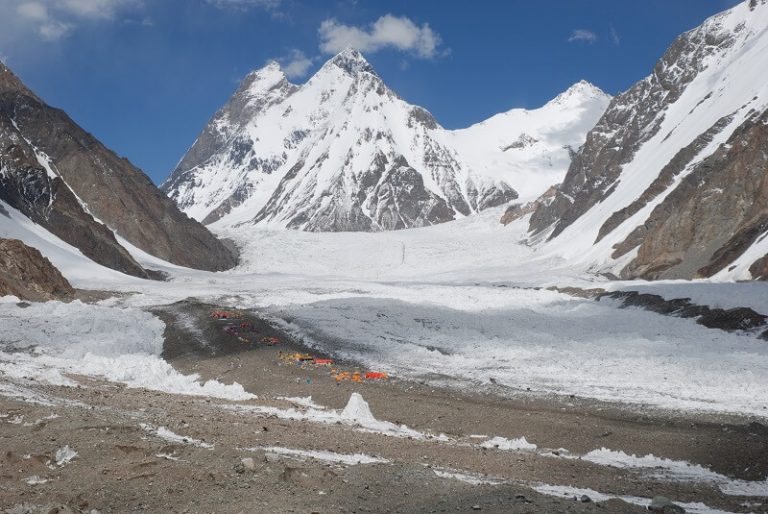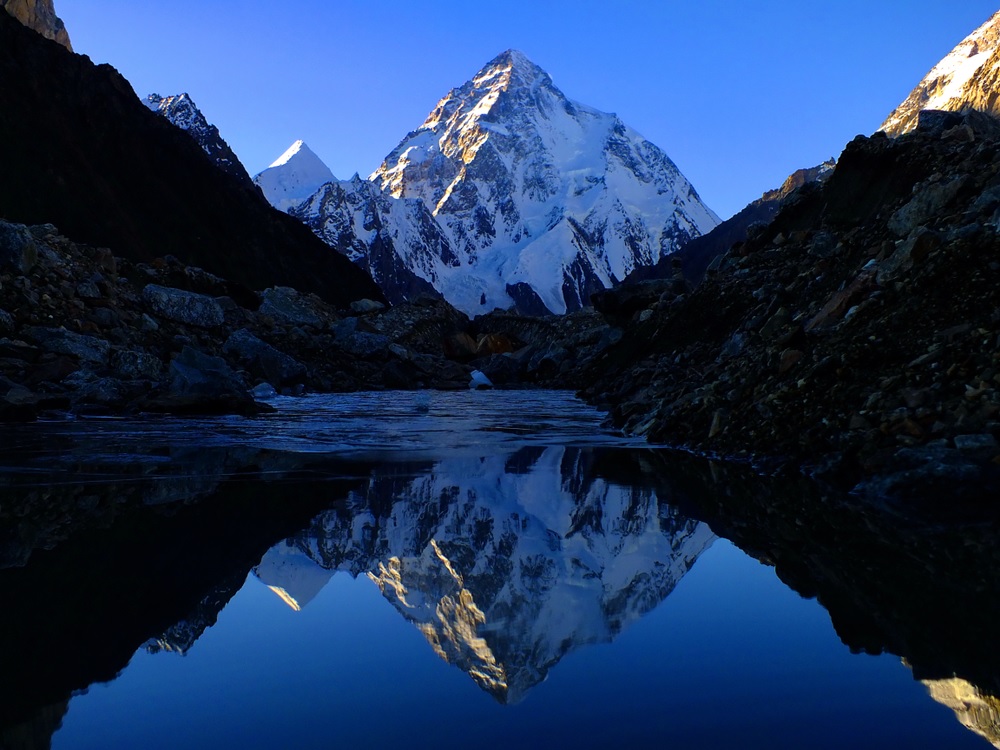
K2 and Concordia Trek
Globally regarded as one of the world’s greatest treks, this challenging adventure takes us to Concordia and the base camps of both K2 and Broad Peak. Throughout this trek you’re spoilt with breath taking scenery, unsurpassed anywhere else in our planets high mountain ranges.
Overview
Globally regarded as one of the world’s greatest treks, this challenging adventure takes us to Concordia and the base camps of both K2 and Broad Peak. Throughout this trek you’re spoilt with breath taking scenery, unsurpassed anywhere else in our planets high mountain ranges.
We initially start with a stunning flight from Islamabad to Skardu before starting our trek. Throughout our trek the route is lined with rugged, snow peaked mountains all the way to Concordia. We trek up the famous Baltoro glacier, underneath the giants of the Trango Towers (6,363m), Masherbrum (7,821m), Muztagh Tower (7,283m), Gasherbrum IV (7,925m), K2 (8,611m), Broad Peak (8,051m) and Chogolisa (7,668m) amongst many others. We then reach Concordia itself, which has been described as the “Throne Room of the Mountain Gods” for its unique 360˚ panorama of 7,000m mountains and impressive views of K2 – here you really are in one of the planets most impressive locations. We overnight at Broad Peak Base Camp which is unusual however it shortens our trek days up high and gives you lot’s more time to really explore, absorb and appreciate this most impressive location.
The Karakoram
Here is a short clip from independent traveller Bilal A that perfectly captures the essence and beauty of this region of the Karakoram.
BREAKDOWN OF THE K2 AND CONCORDIA TREK ITINERARY
Please note that the itinerary given is the outline plan. However, we will be travelling in a high mountain environment with a number of unknown influences including weather and rates of acclimatisation of different individuals. Therefore the itinerary is flexible to some extent to allow our leaders to make appropriate decisions on the ground based on prevailing conditions.
On arrival into Islamabad, you’ll meet your guide and the rest of the team and then transfer to our centrally located hotel. We’ll have a trip briefing, check gear and relax at the hotel here we’ll spend the night.
Today we take the spectacular flight to Skardu, which is located in the heart of the mountain region of Baltistan, the home of the mighty Karakoram! The flight offers stunning scenery and views of some of the biggest and most challenging mountains in the world, such as K2 (8,611m), Nanga Parbat (8,124m), Rakaposhi (7,788m) amongst others. Skardu lies at the edge of a broad floodplain that is the confluence of the Indus, Shyok and Basha rivers. We stay overnight in a popular and comfortable hotel.
Please note: weather conditions in Skardu, or Islamabad can at times affect the flight. If the flight option is removed we’ll instead travel by private air-conditioned coach along the famous Karakoram Highway to Skardu. The Karakoram Highway follows the Indus river, cutting through steep gorges and again offers some spectacular scenery (including views of Nanga Parbat (8,124m) and Rakaposhi (7,788m)). The Karakoram Highway is known as one the 8th wonders of the world. The long journey to Skardu will be spread over 2 days, with a night stopover at Chilas. The drive time will be approximately 10 hours.
If we fly to Skardu then today we’ll go for a jeep safari to the Deosai Plains, also known as the Land of Giants. Deosai is the 2nd highest plateau in the world after the Changtang Tibetan Plateau and has an average height of 4100m. Deosai, with its lush green grass, colourful wildflowers and rare butterflies, is rightly described as “Summer’s Palace” by the locals. The altiude of the Deosai Plains will help us acclimatise as although a short day trip, it will take us over 4000m and you’ll expect to feel the impact of the thinner air. We’ll enjoy lunch at the beautiful Sheosar lake, which offers spectacular views of Nanga Parbat (8,124m). We’ll then drop out of altitude and return to our hotel in Skardu.
If we’re travelling by road, then the journey from Chilas to Skardu will take 7-8 hours. Alongside the spectacular mountain scenery, we’ll also see the confluence of the planets three biggest mountain ranges being the Karakoram, Himalayas and Hindu Kush.
In the morning we’ll attend an official briefing by the tourism department regarding our trek in the Karakoram National Park. After this we’ll have some free time for final kit check and if needed we can buy anything that’s needed. If times allows we can also visit Katchura Lake and Skardu fort. The view from the fort is stunning, with Skardu city and the Indus River framed by the Karakoram Range.
We’ll then overnight in the hotel.
Today we start our journey into the Karakoram by first travelling by jeep to Askoli. The road to Askoli passes through the stunning valleys of Shigar and Braldu, each having its own mystique and uniqueness. Shigar valley comprises of several villages and farms with fields of wheat, barley, apricot trees and cherry trees. The taste of apricots and cherries of Shigar valley is second to none. Locals will greet us with big smiles as we pass, and will show us their hospitality by inviting us to their farms to eat fresh apricots and cherries!
The landscape then becomes more desert-like, with barren mountains and steep gorges, as we approach the Braldu valley. We’ll cross several suspension bridges over the Braldu River, which is a lofty experience at times. Due to the steep mountain environment the road is prone to land slides and can at times be blocked, which can delay our journey. On arriving at Askoli village we’ll go to the campsite and spend our first night camping (2 people / tent). The campsite is home to trekkers and climbers from all around the globe. It’s very friendly and hospitable, as are the people of Askoli. The local area is full of crops such as wheat, vegetables and fruits, alongside large herds of goats and sheep. After our evening meal we’ll have a briefing about the next day’s schedule, then relax.
After our approach by road and air we now start our trek towards K2! A short distance along the trail we’ll register at the Karakoram National Park (CKNP) office, then proceed along the Braldu valley, which opens up to reveal the Mighty Biafo glacier, that flows from the Hispar Pass and Snow Lake into the valley. Biafo Glacier is a massive 67 km long glacier and is the world’s 3rd longest glacier outside of the polar-regions. We’ll have our first experience of moraine walking as we cross the snout of the glacier to reach Korophong and our lunch spot beside the river.
After lunch we continue along the valley, until we reach the confluence of the Braldu River and Dumordo River (flowing from the Panmah Glacier). This is where the famous ‘Joula’ or flying fox is located and was in the past used to cross the fast flowing Dumordo River. Nowadays a footbridge has been built, making the crossing of river much safer! The Dumordo River valley leads to the Panmah, Chaktoi, Nobande-Sobande and Chiring glaciers. It also connects with the Sim (5,833m), Skam (5,407m) and West Muztagh (5,735m) Passes and has views of many famous Karakoram peaks such Latok 1 (7,151m), Latok 2 (7,108m), Biantha Brakk (7,285m). This valley once used to be a passage between Baltistan and Yarkhand through West Muztagh Pass (5,735m) into China. After crossing the river, we will walk along the river bank to the Joula campsite.
We start the day early and walk along the Braldu River to reach our destination for the the day the Paiju campsite. Todays route gradually gains altitude but undulates along the river bank due to differing levels of erosion and changing water levels. We’ll enjoy lunch at the former campsite at Bardumal before contnuing our trek. As we do, we may get glimpses of the Masherbrums to our right via the Xiangang Valley. The Masherbrum range is large number of peaks along the south side of Baltoro Glacier.
It’s common for the walk to be very hot and dry today, and can lead to difficult walking conditions. As we approach our destination, Paiju campsite we’ll pass several small, glacial fed, streams and if we’re lucky we’ll catch sight of Trango Towers and Uli Biaho.
Today is a rest and acclimatisation day. There is an option to go for a short trek above the village, to again gain some altitude and enjoy views of the Trango Towers and if we’re very lucky the distance, yet still impressive K2. Otherwise we’ll relax at the campsite which is an international hub of trekkers and climbers.
After a good breakfast we’ll leave camp and after an hour we’ll approach the mighty Baltoro glacier. The Baltoro glacier is an impressive sight as it stretches across the Braldu River, but it’s not until you spot the people, that appear like ants, crossing the glacier does its size become apparent. The glacial ice rises over 70m above the river at it’s snout. Due to its ever-changing nature, the glacial moraine can be difficult to navigate but you’ll be in expert hands with your guide.
This can be a hard days walking and on the other side of the valley, and often requires some stream crossings. From this point onwards we’re treated to uninterrupted views of Paiju Peak (6,610m), Uli Biaho Tower (6,109m), Trango Towers (6,363m) and Cathedral Peak (6,024m) and behind us are the contrasting steep grassy grazing pastures of the ibex. We then cross the Liligo glacier, which flows from the south of the Baltoro glacier, and reach our campsite at Khoburtse, which is opposite the Trango Towers.
Today is a short trek for around 4 hrs however our height gain of 350m is a comfortable gain in altitude and to assist with our acclimatisation we’ll relax in the afternoon.
We’ll leave camp and initially continue along the south side of the Baltoro glacier. Depending on the conditions our route will either be along the moraine or perhaps at times on the glacier. We’ll also cross two glaciers flowing down from Urdukas Peak (6,320m). W’ll then pass Trango Towers and Cathedral Peak, both of which are on the north side of Baltoro glacier and arrive at Urdukas by lunchtime. Urdukas campsite is a fascinating place perched a 100m above the glacier on terraces that were originally hacked out of the hillside by the Duke of Abruzzi’s K2 expedition in 1909. The views from the campsite have to be amogst the best campsite views in the world as you sit and soak up Trango Towers (6,363m) to the west, and the vast rock walls of Cathedral Peak (6,024m) and Lobsang (5,707m). It is really an amazing campsite! From here we should also be able to see Broad Peak (8,051m) and Gasherbrum IV (7,925m) at the head of the valley.
After breakfast we’ll leave Urdukas campsite and initially follow the moraine along the edge of the glacier before crossing to the centre of the glacier, where it’s easier to walk. Soon we will be able to see the spectacular Masherbrum (7,821m) to our right hand side, along with the vast Yermamendu glacier flowing from the south. We will constantly ascend and descend the mountains of rubble which are scattered over the ice. Ahead of us lie the peaks of Concordia, including the stunning Broad Peak (8,051m) and Gasherbrum IV (7925m). Looking back towards Paiju, the impressive mountains that initially dominated our views in the early days of the trek, now seem to be dwarfed. At this point, being at high altitude and camping on one of the largest pieces of ice outside the polar-regions, you can expect cold nights. Again we camp in a fully facilitated campsite at Goro II.
The final approach day to Concordia takes us through what is arguably the most spectacular mountain scenery anywhere in the world! Concordia is considered one of the world’s most spectacular campsites as it is surrounded by numerous giant and famous peaks of the Karakoram, and offers the highest concentration of +7,000 meters peaks anywhere in the world.
After leaving Goro II campsite, the Biange glacier to the north will provide us with a spectacular view of Muztagh Tower (7,283m), which is considered one of the most technical mountains to climb in the Karakoram. The trail is fairly easy to trek on, with gentle slopes of moraine. Here we will also see the famous “Ice Cubes” of Baltoro glacier, which are ice towers or seracs rising 40-60 meters out of the glacier.
Approaching Concordia, Mitre Peak (6,070m) will be to our right, with Baltoro Kangri (7,300m) beside it, while the Gasherbrum Group will be directly before us. The expanse of Broad Peak (8,052m) is to the left and finally the Mountain of Mountains, the mighty K2 (8,611m) will be looming above the ridge as it towers over the Godwin Austen Glacier 12 km away. K2 is hidden until the very moment we reach Concordia, when suddenly its full height is revealed, in sweeping lines that climb almost 4,000 meters from the valley floor to the summit – a sight that will never be forgotten!
Concordia is a wide area where glaciers coming down from K2 meet those from the Gasherbrums and Chogolisa, and makes a perfect base from which to explore and enjoy some of the highest mountains in the world. Here you can stand within 24 km of no fewer than 4 eight-thousand metre mountains and ten of the world’s thirty highest peaks! Very few people are fortunate enough to witness this sight.
Over the next few days our schedule can have a degree of flexibility, depending on the group preferences and prevailing weather conditions. One of our main objectives is to visit the K2 Base Camp (4,980m), Broad Peak Base Camp (4,850m) and the Gilkey Memorial. Plus we also have the option of a relatively easy trek to the Upper Baltoro Glacier and the Abruzzi Glacier to Gasherbrum I Base Camp (5,156m). Here we will be able to see several majestic peaks like Gasherbrum I (8,080m), Gasherbrum II (8,035m), Chogolisa (7,668m), Baltoro Kangri (7,300m) and Snow Dome (7,150m).Another option can be to relax at Concordia and enjoy the might of several mountains that are already before us: K2 (8,611m), Broad Peak (8,052m), Gasherbrum IV (7,952m), Baltoro Kangri (7,300m), Marble Peak (6,256m), Mitre Peak (6,070m).
If all goes to plan then the ideal itinerary is to wake up early this morning to see the sunrise over Gasherbrum IV (7,925m), K2 (8,611m) and Broad Peak (8,052m). Then after some breakfast we’ll make our way towards Broad Peak Base Camp (4,850m), and arrive around lunch time. There is a bit of tricky ground where the Baltoro and Godwin Austen glaciers meet, which then leads onto easy terrain. We then follow the moraine of the Godwin Austen Glacier to our campsite at Broad Peak BC which again offers sensational views of K2, Mitre Peak and Chogolisa. A number of expeditions will be at base camp and it’s a great opportunity to have a chat with some of the climbers.
Most companies trek from Concordia to Broad Peak BC to K2 base camp and back to Concordia in one day, however it makes for a very long day, too long in fact, as it gives you little time to absorb the views and atmosphere properly.
We’ll start the day early in order to visit K2 Base Camp and then trek back to Concordia. Due to our gradual ascent and due to using an extra camp at Broad Peak BC we will be well acclimatised and after 3 hours we’ll reach K2 Base Camp (4,980m). From here, we will see the Savoia Saddle to the west, Windy Gap and Advance Base Camp on the Abruzzi Ridge to the east and Concordia framed by Mitre Peak and Chogolisa to the south, and of course K2 to the north. This will be an unforgettable experience as you relax, absorb the scenery and explore base camp! We will also visit the Gilkey Memorial where the names of those who have died climbing K2 are inscribed on a collection of plaques and plates.
We’ll have lunch at K2 Base Camp, before heading back to Concordia in the afternoon by following the Godwin Austen Glacier. As we walk in the opposite direction we are again treated to stunning views as we start to drop out of altitude. The return trek will take 5 hours, so we’ll reach Concordia campsite just before dinner.
After enjoying our last views of K2 and her surrounding peaks we head back towards the Baltoro Glacier. We’ll retrace our steps however looking in a different direction and with ever changing weather, things are always changing in the mountain environment, so views and just ‘being’ there will continue to be an enjoyable experience.
Now on the descent, we can cover more ground and will drop past Goro II onto another campsite called Goro I, which is right in front of Masherbrum (7,821m). We can relax in camp and enjoy views of many different peaks and Masherbrum, which is one of the most technical peaks in the world.
Today we continue our descent down the Baltoro Glacier. Our horizon is filled with stunning peaks of Lobsang (6,225m), Cathedral (6,024m), Trango Towers (6,363m), Uli Biaho (6,41m) and Paiju (6,610m). Todays trek is a mix of morriane at the sides of the great glacier, or on the glacier itself, until we reach Khoburtse campsite, and our first non glacier based campsite for some days. Khoburtse campsite is on the south side of Baltoro glacier, just opposite Trango Towers
A short while after leaving Khoburtse, we cross the Liligo Glacier, that extends from the south of the Baltoro Glacier. This glacier defies world trends in that it is steadily growing! 20 years ago, its snout was half a mile up the valley, but now it has reached the main Baltoro Glacier.
As we descend our first treat of the day is a stunning view of Trango’s Nameless Tower (6,239m). We’ll then have lunch near the snout of the glacier, before crossing to it’s northern side after which we leave the Baltoro Glacier behind us. Further along the trail we reach our campsite back at Paiju. Tonight we’ll enjoy local songs and dances as the porters relax in the happiness of a successful trek and return from the Baltoro Glacier.
Dropping out of altitude and now off the glacier, the weather can be hot, therefore we’ll make the most of the cooler mornings and leave camp early. Initially we follow a good trail down the Braldu valley along the river until it meets the Domordo River. Further downstream we’ll seek some shade and have lunch at Bardumal. After lunch, and having missed the midday sun, we’ll walk for a further 2hrs to our camp at Joula for mid afternoon.
After two weeks in the wilderness we now reach our final day of trekking and our return to civilisation. Today is a relatively easier 6-7 hours trek that returns us to Askoli village.
As we leave Joula we cross the fast flowing Dumordo river via the footbridge and follow the trail, which is carved into the side of the rocky slopes. This leads on to a pleasant trail towards Korophong and our lunch spot beside the river. Later, we will experience our last glacier crossing, as we cross the glacial moraine at the snout of the Biafo Glacier and, after a couple of hours of relatively easy trek, we reach Askoli, where most of our porters are from. After freshening up, we will say goodbye to our porter team, who by now will have become friends and quite often a party is enjoyed.
After saying goodbye to the porter team we now make our way back to Skardu, which is about 6-8 hours jeep ride from Askoli. The pleasant and picturesque drive takes us back through the through the Braldu and Shigar valleys with us reaching our hotel in Skardu by early / mid afternoon. We can relax in the afternoon before our official trek debriefed by the tourism department in the early evening.
All being well with the weather we’ll take the spectacular flight from Skardu back to Islamabad, and this time enjoy the views of K2, Nanga Parbat, Rakaposhi and other Karakoram peaks from the air. We’ll then check into our comfortable city hotel and in the evening enjoy a meal at the famous Monal Restaurant, which is perched in Margalla Hills and offers spectacular views over the city.
If we do have inclement weather that impacts our flight, we’ll instead travel on a private air-conditioned coach along the Karakoram Highway to Islamabad. Due to the long distance and travel time, we’ll split the journey with an overnight in a Chilas hotel, which is roughly 8 hrs from Askoli.
If we arrive at Islamabad by air, we’ll spend the day relaxing, sightseeing and / or shopping.
Or if we’re travelling by road, we’ll arrive into Islamabad from Chilas late in the afternoon after a 10 hour drive. We’ll enjoy a well deserved shower, cold drink and a good meal.
After breakfast, we’ll say goodbye to each other and your guide before being transferred to the airport for your onward flight.
Ready for an Adventure of a Lifetime?
Choose a scheduled date or contact us to set up private dates or a bespoke itinerary. The minimum deposit is £200.00 and the balance is due six weeks before travel.
Fixed Itineraries
No upcoming trips found.

